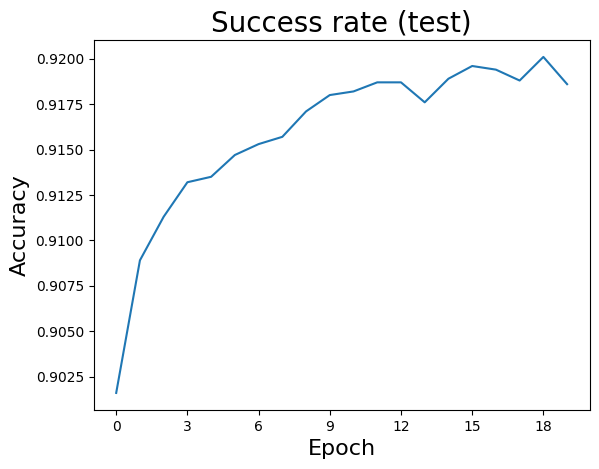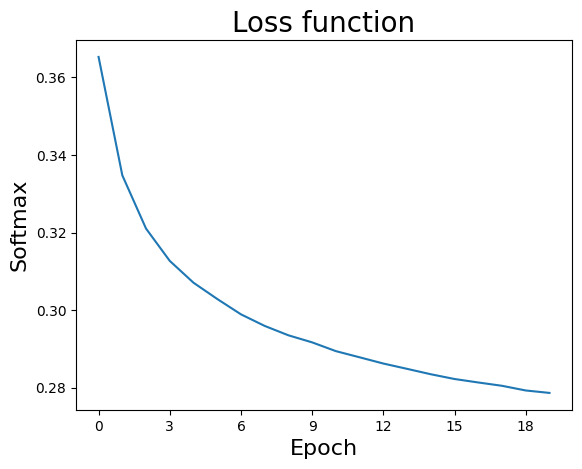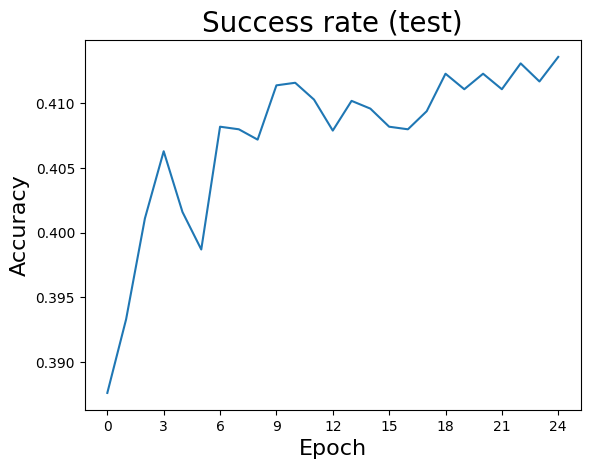SGD
Consider cost functional
\(f(\cdot) : \mathbb{R}^M \mapsto \mathbb{R}\) is differentiable.
The opposite of the gradient, i.e. \(- \nabla F(\mathbf{u})\) always points towards the minimum \(\mathbf{u}^*\):
\[\begin{eqnarray*} \forall\epsilon> 0 & & \inf_{\| \mathbf{u}-\mathbf{u}^* \|_2^2} \langle \mathbf{u}-\mathbf{u}^*, \nabla F(\mathbf{u}) \rangle > 0\end{eqnarray*}\]
Softmax loss function (for a full explanation see Lecture 3b’s introduction)
\[\begin{eqnarray*} F(\mathbf{W}) & = & \sum_{n=0}^N \langle \mathbf{x}_n, \mathbf{w}_{_{\mathbf{\cal{L}}_n}} \rangle + \sum_{n=0}^N \log\left( \sum_{l=0}^{L-1} \mbox{e}^{ -\langle \mathbf{x}_n, \mathbf{w}_{l} \rangle }\right) \end{eqnarray*}\]where
\(\mathbf{W} \in \mathbb{R}^{L \times S }\)
\(L\) represent the number of classes
\(S\) represent the number of ‘features’
\(\mathbf{X} \in \mathbb{R}^{N \times S }\) represents the training dataset,
and
\(\mathbf{w}_l\) represents the l-th column of matrix \(\mathbf{W}\).
\(\mathbf{x}_n\) represents one training data.
def softmax_L2_cost(X, Y, W, lmbd):
fCost = np.sum(np.log(np.sum(np.exp(-X.transpose().dot(W)), axis=1)))
fCost += np.sum( X*W[:,Y] )
fCost /= float(X.shape[1])
if lmbd > 0:
fCost += lmbd*(sum( np.power(W.ravel(),2) ))/float(X.shape[1])
return fCost
def softmax_L2_grad(X, Y, W, n, lmbd):
z = X[:,np.ix_(n)].squeeze(1) # select batch elements
g = -z.dot( softmax(-z.transpose().dot(W),axis=1) )
for k in range(len(n)):
g[:,Y[n[k]] ] += z[:,k] # Y is assumed to be ravel()
g /= float(len(n))
if lmbd > 0:
g += lmbd*W
return g
def stdPreproc(dIn, L=255.0, flagNorm=True, flagMean=True):
dIn = dIn.astype("float")
if flagNorm:
dIn = dIn/L
if flagMean:
mean = np.mean(dIn, axis = 0)
dIn -= mean
return(dIn)
import tensorflow as tf
from tensorflow import keras
from tensorflow.keras.datasets import mnist
from tensorflow.keras.datasets import cifar10
(X, Y), (Xtest, Ytest) = mnist.load_data()
#(X, Y), (Xtest, Ytest) = cifar10.load_data()
# standard pre-processing
X = stdPreproc(X)
Xtest = stdPreproc(Xtest)
# if needed --> data vectorization
X = np.transpose( X.reshape(X.shape[0], np.array(X.shape[1::]).prod()) )
Xtest = np.transpose( Xtest.reshape(Xtest.shape[0], np.array(Xtest.shape[1::]).prod()) )
Y = Y.ravel()
Ytest = Ytest.ravel()
Problem: write you own SGD routine; as a test function use the Softmax function (as described in “Softmax loss” tab of the above panel); use the MNIST / CIFAR10 dataset and solve the multiclass classification problem using your SGD routine.
Proposed solution
Among other pausible alternatives, the SGD algorithm may be written as
def hosgdSGD(OptProb, nEpoch, blkSize, alpha0, hyperFun):
W = OptProb.randSol()
stats = np.zeros( [nEpoch, OptProb.Nstats] )
nBlk = np.floor_divide(OptProb.X.shape[1],blkSize)
if np.remainder(OptProb.X.shape[1],blkSize) > 0:
nBlk += 1
k = 0
for e in range(nEpoch):
# Generate permutation
blkInd = 0
perm = np.random.permutation(OptProb.X.shape[1])
for b in range(nBlk):
# general iteration counter
k += 1
# select indexes
if b <= nBlk-2:
n = perm[blkInd:blkInd+blkSize]
else:
n = perm[blkInd:OptProb.X.shape[1]]
blkInd += blkSize
# Compute the gradient
g = OptProb.gradFun(W, n)
alpha = hyperFun.LR(W, alpha0, e, None)
W = W - alpha*g
# _END_ for(b)
stats[e,:] = OptProb.computeStats(W, alpha, e, g)
OptProb.printStats(e, nEpoch, stats)
return W, stats
def hosgdSGD(OptProb, nEpoch, blkSize, alpha0, hyperFun):
OptProb
classthat encapsultes a particular optimization problem.Given the function \(F(\cdot) : \mathbb{R}^N \mapsto \mathbb{R}\), this
classshould implementcostFun: computes the cost functional.gradFun: computes the gradient, i.e. \( \nabla F(\cdot) \).randSol: generates a random initial solutioncomputeStats: gathers useful statistics (e.g. cost functional, current learning rate value, etc.).computeSuccess: if a test dataset is given, then compute the succes rate.
class hosgdFunSoftMax(hosgdOptProb):
r""" F(W) = (1/N) \sum_n f_n(W)
f_n(W) = < Xn, Wl_n > + log( \sum_l e^{ -< Xl, Wl >} )
"""
def __init__(self, X, Y, nClass, Xtest=None, Ytest=None, lmbd=0,
gNormOrd=2, Nstats=5, verbose=10, initSol=None):
self.X = X
self.Y = Y
self.nClass = nClass
self.Xtest = Xtest
self.Ytest = Ytest
self.lmbd = lmbd
self.Nstats = Nstats
self.gNormOrd = gNormOrd
self.verbose = verbose
self.initSol = initSol # if not None --> reproducible initial solution
# ---------
def costFun(self, W):
fCost = np.sum(np.log(np.sum(np.exp(-self.X.transpose().dot(W)), axis=1)))
fCost += np.sum( self.X*W[:,self.Y] )
fCost /= float(self.X.shape[1])
if self.lmbd > 0:
fCost += self.lmbd*(sum( np.power(W.ravel(),2) ))/float(self.X.shape[1])
return fCost
# ---------
def fwOp(self, W):
return None
# ---------
def gradFun(self, W, n):
z = self.X[:,np.ix_(n)].squeeze(1) # select batch elements
g = -z.dot( softmax(-z.transpose().dot(W),axis=1) )
for k in range(len(n)):
g[:,self.Y[n[k]] ] += z[:,k]
g /= float(len(n))
if self.lmbd > 0:
g += self.lmbd*W
return g
# ---------
def randSol(self):
if self.initSol is None:
rng = np.random.default_rng()
else:
rng = np.random.default_rng(self.initSol)
return 0.01*rng.normal(size=[self.X.shape[0], self.nClass] )
# ---------
def computeStats(self, W, alpha, k, g):
cost = self.costFun(W)
gNorm = self.gradNorm(g, self.gNormOrd)
success = self.computeSuccess(W)
return np.array([k, cost, alpha, gNorm, success])
# ---------
def computeSuccess(self, W):
if self.Xtest is not None and self.Ytest is not None:
classVal = -np.matmul(self.Xtest.transpose(), W)
success = sum( np.argmax(classVal,axis=1) == self.Ytest )
return float(success)/float(self.Xtest.shape[1])
else:
return None
# ---------
def printStats(self, k, nEpoch, v):
if k == 0:
print('\n')
if self.verbose > 0:
if np.remainder(k,self.verbose)==0 or k==nEpoch-1:
if v[k,4] is None:
print('{:>3d}\t {:.3e}\t {:.2e} {:.2e}'.format(int(v[k,0]),v[k,1],v[k,2],v[k,3]))
else:
print('{:>3d}\t {:.3e}\t {:.2e} {:.2e}\n \t \
success rate (training): {:.3e}'.format(int(v[k,0]),v[k,1],v[k,2],v[k,3],v[k,4]))
return
# ---------
def gradNorm(self, g, ord=2):
if g is None:
return -1.0
if ord == 2:
return np.linalg.norm(g.ravel(),ord=ord)**ord
else:
return np.linalg.norm(g.ravel(),ord=ord)
nEpoch
blkSize
alpha0
hyperFun
classthat encapsultes any functionality related to SGD’s hyper-parameters.Up to this point, this
classwould only focus on replicating the initial learning rate \(\alpha_0\) or in implementing a Step-decay policy.
class hosgdHyperFunSGD(object):
r"""Class related to routines associated to hyperPars computation
"""
def __init__(self, lrPolicy=hosgdDef.lrSGD.Cte, lrSDecay=20, lrTau = 0.5):
self.lrPolicy = lrPolicy
self.LR = self.sel_LR()
self.lrSDecay = lrSDecay
self.lrTau = lrTau
def sel_LR(self):
switcher = {
hosgdDef.lrSGD.Cte.val: self.lrCte,
hosgdDef.lrSGD.StepDecay.val: self.lrStepDecay,
}
lrFun = switcher.get(self.lrPolicy.val, "nothing")
func = lambda u, alpha, k, g: lrFun(u, alpha, k, g)
return func
# --- === ---
def lrCte(self, u, alpha, k, g):
return alpha
# --- === ---
def lrStepDecay(self, u, alpha, k, g):
return (self.lrTau**np.floor(k/self.lrSDecay))*alpha
from enum import Enum, IntEnum, unique
@unique
class lrSGD(Enum):
Cte = (0, 'Cte lerning rate')
StepDecay = (1, 'StepDecay')
def __init__(self, val, txt):
self.val = val
self.txt = txt
@classmethod
def printLR(cls):
for k in cls:
print('lrSGD.{}:'.format(k.name), k.val, k.txt)
Simulation
1. Load dataset
def stdPreproc(dIn, L=255.0, flagNorm=True, flagMean=True):
dIn = dIn.astype("float")
if flagNorm:
dIn = dIn/L
if flagMean:
mean = np.mean(dIn, axis = 0)
dIn -= mean
return(dIn)
import tensorflow as tf
from tensorflow import keras
from tensorflow.keras.datasets import mnist
from tensorflow.keras.datasets import cifar10
(X, Y), (Xtest, Ytest) = mnist.load_data()
#(X, Y), (Xtest, Ytest) = cifar10.load_data()
# standard pre-processing
X = stdPreproc(X)
Xtest = stdPreproc(Xtest)
# if needed --> data vectorization
X = np.transpose( X.reshape(X.shape[0], np.array(X.shape[1::]).prod()) )
Xtest = np.transpose( Xtest.reshape(Xtest.shape[0], np.array(Xtest.shape[1::]).prod()) )
Y = Y.ravel()
Ytest = Ytest.ravel()
2. Load the optimization problem
# --- Optimization model
# --- (see "Parameters", "OptProb", "E.g. Softmax"
# in the tabbed panel above)
# ---------------------------------------------------------
nClasses = 10
OptProb = hosgdFunSoftMax(X, Y, nClasses, verbose=1, Xtest=Xtest, Ytest=Ytest)
3. Select the hyper-parameters routines
# --- It is assumed that class 'lrSGD' is defined
# in file 'HoSGDdefs.py'
# --- (see "Parameters", "hyperFun", "class lrSGD"
# in the tabbed panel above)
# ---------------------------------------------------------
import HoSGDdefs as hosgdDef
# --- hyperPars
# --- (see "Parameters", "hyperFun", "E.g."
# in the tabbed panel above)
# ---------------------------------------------------------
hyperP = hosgdHyperFunSGD(OptProb, lrPolicy=hosgdDef.lrSGD.Cte)
# alternatively:
# hyperP = hosgdHyperFunSGD(OptProb, lrPolicy=lrPolicy, lrSDecay=lrSDecay, lrTau=lrTau)
4. Execute SGD
# --- nEpoch, blkSize, alpha0: user defined.
# --- OptProb: see #2 in the current list
# --- hyperP: see #3 in the current list
W, stats = hosgdSGD(OptProb, nEpoch, blkSize, alpha, hyperP)
Full solution
HoSGDdefs.py
from enum import Enum, IntEnum, unique
@unique
class lrSGD(Enum):
Cte = (0, 'Cte lerning rate')
StepDecay = (1, 'StepDecay')
def __init__(self, val, txt):
self.val = val
self.txt = txt
@classmethod
def printLR(cls):
for k in cls:
print('lrSGD.{}:'.format(k.name), k.val, k.txt)
ReLU = (0, 'ReLU')
RReLU = (1, 'Rand ReLU')
ELU = (2, 'ELU')
def __init__(self, val, txt):
self.val = val
self.txt = txt
@classmethod
def printLR(cls):
for k in cls:
print('actFun.{}:'.format(k.name), k.val, k.txt)
@unique
class hlFun(Enum):
dense = (0, 'Dense (matrix times)')
def __init__(self, val, txt):
self.val = val
self.txt = txt
HoSGDL1b.py
import numpy as np
import scipy as sc
from scipy import signal
from scipy.special import softmax,logsumexp
import matplotlib.pylab as PLT
from matplotlib.ticker import MaxNLocator
import HoSGDdefs as hosgdDef
from HoSGDdefs import hosgdOptProb
import os
os.environ['TF_CPP_MIN_LOG_LEVEL'] = '2' # Disbales TF's warnings (they don' shown in generated HTML)
# Note: TF is used to have a simple access to MNIST
import tensorflow as tf
from tensorflow import keras
from tensorflow.keras.datasets import mnist
from tensorflow.keras.datasets import cifar10
class hosgdHyperFunSGD(object):
r"""Class related to routines associated to hyperPars computation
"""
def __init__(self, lrPolicy=hosgdDef.lrSGD.Cte, lrSDecay=20, lrTau = 0.5):
self.lrPolicy = lrPolicy
self.LR = self.sel_LR()
self.lrSDecay = lrSDecay
self.lrTau = lrTau
def sel_LR(self):
switcher = {
hosgdDef.lrSGD.Cte.val: self.lrCte,
hosgdDef.lrSGD.StepDecay.val: self.lrStepDecay,
}
lrFun = switcher.get(self.lrPolicy.val, "nothing")
func = lambda u, alpha, k, g: lrFun(u, alpha, k, g)
return func
# --- === ---
def lrCte(self, u, alpha, k, g):
return alpha
# --- === ---
def lrStepDecay(self, u, alpha, k, g):
return (self.lrTau**np.floor(k/self.lrSDecay))*alpha
# ===========================================
class hosgdFunSoftMax(hosgdOptProb):
r""" F(W) = (1/N) \sum_n f_n(W)
f_n(W) = < Xn, Wl_n > + log( \sum_l e^{ -< Xl, Wl >} )
"""
def __init__(self, X, Y, nClass, Xtest=None, Ytest=None, lmbd=0,
gNormOrd=2, Nstats=5, verbose=10, initSol=None):
self.X = X
self.Y = Y
self.nClass = nClass
self.Xtest = Xtest
self.Ytest = Ytest
self.lmbd = lmbd
self.Nstats = Nstats
self.gNormOrd = gNormOrd
self.verbose = verbose
self.initSol = initSol # if not None --> reproducible initial solution
# ---------
def costFun(self, W):
fCost = np.sum(np.log(np.sum(np.exp(-self.X.transpose().dot(W)), axis=1)))
fCost += np.sum( self.X*W[:,self.Y] )
fCost /= float(self.X.shape[1])
if self.lmbd > 0:
fCost += self.lmbd*(sum( np.power(W.ravel(),2) ))/float(self.X.shape[1])
return fCost
# ---------
def fwOp(self, W):
return None
# ---------
def gradFun(self, W, n):
z = self.X[:,np.ix_(n)].squeeze(1) # select batch elements
g = -z.dot( softmax(-z.transpose().dot(W),axis=1) )
for k in range(len(n)):
g[:,self.Y[n[k]] ] += z[:,k]
g /= float(len(n))
if self.lmbd > 0:
g += self.lmbd*W
return g
# ---------
def randSol(self):
if self.initSol is None:
rng = np.random.default_rng()
else:
rng = np.random.default_rng(self.initSol)
return 0.01*rng.normal(size=[self.X.shape[0], self.nClass] )
# ---------
def computeStats(self, W, alpha, k, g):
cost = self.costFun(W)
gNorm = self.gradNorm(g, self.gNormOrd)
success = self.computeSuccess(W)
return np.array([k, cost, alpha, gNorm, success])
# ---------
def computeSuccess(self, W):
if self.Xtest is not None and self.Ytest is not None:
classVal = -np.matmul(self.Xtest.transpose(), W)
success = sum( np.argmax(classVal,axis=1) == self.Ytest )
return float(success)/float(self.Xtest.shape[1])
else:
return None
# ---------
def printStats(self, k, nEpoch, v):
if k == 0:
print('\n')
if self.verbose > 0:
if np.remainder(k,self.verbose)==0 or k==nEpoch-1:
if v[k,4] is None:
print('{:>3d}\t {:.3e}\t {:.2e} {:.2e}'.format(int(v[k,0]),v[k,1],v[k,2],v[k,3]))
else:
print('{:>3d}\t {:.3e}\t {:.2e} {:.2e}\n \t \
success rate (training): {:.3e}'.format(int(v[k,0]),v[k,1],v[k,2],v[k,3],v[k,4]))
return
# ---------
def gradNorm(self, g, ord=2):
if g is None:
return -1.0
if ord == 2:
return np.linalg.norm(g.ravel(),ord=ord)**ord
else:
return np.linalg.norm(g.ravel(),ord=ord)
# ===========================================
def hosgdSGD(OptProb, nEpoch, blkSize, alpha0, hyperFun):
W = OptProb.randSol()
stats = np.zeros( [nEpoch, OptProb.Nstats] )
nBlk = np.floor_divide(OptProb.X.shape[1],blkSize)
if np.remainder(OptProb.X.shape[1],blkSize) > 0:
nBlk += 1
k = 0
for e in range(nEpoch):
# Generate permutation
blkInd = 0
perm = np.random.permutation(OptProb.X.shape[1])
for b in range(nBlk):
# general iteration counter
k += 1
# select indexes
if b <= nBlk-2:
n = perm[blkInd:blkInd+blkSize]
else:
n = perm[blkInd:OptProb.X.shape[1]]
blkInd += blkSize
# Compute the gradient
g = OptProb.gradFun(W, n)
alpha = hyperFun.LR(W, alpha0, e, None)
W = W - alpha*g
# _END_ for(b)
stats[e,:] = OptProb.computeStats(W, alpha, e, g)
OptProb.printStats(e, nEpoch, stats)
return W, stats
def stdPreproc(dIn, L=255.0, flagNorm=True, flagMean=True):
dIn = dIn.astype("float")
if flagNorm:
dIn = dIn/L
if flagMean:
mean = np.mean(dIn, axis = 0)
dIn -= mean
return(dIn)
def exMultiClass(nEpoch, blkSize, alpha, dataset='mnist', lrPolicy=hosgdDef.lrSGD.Cte, lrSDecay=20, lrTau = 0.5, verbose=5):
# Examples
# w, stats = H.exMultiClass(20, 32, 0.05, dataset='mnist')
# w, stats = H.exMultiClass(20, 32, 0.01, dataset='cifar10')
# w, stats = H.exMultiClass(25, 64, 0.02, dataset='cifar10', lrPolicy=hosgdDef.lrSGD.StepDecay, lrSDecay=10, lrTau=0.5)
# --- Load data
# -------------------
flagDataset = False
if dataset.lower() == 'mnist':
(X, Y), (Xtest, Ytest) = mnist.load_data()
flagDataset = True
if dataset.lower() == 'cifar10':
(X, Y), (Xtest, Ytest) = cifar10.load_data()
flagDataset = True
if flagDataset is False:
print('Dataset {} is no valid'.format(dataset))
return
if verbose == 1:
print('Shape (training data):', X.shape)
print('Shape (valid/testing data):', Xtest.shape)
print('\n')
# pre-processing
X = stdPreproc(X)
Xtest = stdPreproc(Xtest)
# Data vectorization
X = np.transpose( X.reshape(X.shape[0], np.array(X.shape[1::]).prod()) )
Xtest = np.transpose( Xtest.reshape(Xtest.shape[0], np.array(Xtest.shape[1::]).prod()) )
Y = Y.ravel()
Ytest = Ytest.ravel()
# --- Optimization model
# ----------------------
OptProb = hosgdFunSoftMax(X, Y, 10, verbose=verbose, Xtest=Xtest, Ytest=Ytest)
# --- HyperPar (this is kept in order to have a similar structure to the SD case (see Lab 1a)
# ------------
hyperP = hosgdHyperFunSGD(lrPolicy=lrPolicy, lrSDecay=lrSDecay, lrTau=lrTau)
# --- Call GD
# -----------
W, stats = hosgdSGD(OptProb, nEpoch, blkSize, alpha, hyperP)
# --- Plot results
# ----------------
plotSGDStats(stats)
return W, stats
def plotSGDStats(stats):
# --- Plot results ---
ax = PLT.figure().gca()
ax.xaxis.set_major_locator(MaxNLocator(integer=True))
PLT.plot(stats[:,1] )
PLT.ylabel('Softmax', fontsize=16)
PLT.xlabel('Epoch', fontsize=16)
PLT.title('Loss function', fontsize=20)
if stats[0,4] is not None:
ax = PLT.figure().gca()
ax.xaxis.set_major_locator(MaxNLocator(integer=True))
PLT.plot(stats[:,4] )
PLT.ylabel('Accuracy', fontsize=16)
PLT.xlabel('Epoch', fontsize=16)
PLT.title('Success rate (test)', fontsize=20)
PLT.show()
Simple Simulation (MNIST)
import numpy as np
import HoSGDlabSGD as H
# MNIST
w, stats = H.exMultiClass(20, 32, 0.05, dataset='mnist')


Simple Simulation (CIFAR10)
import numpy as np
import HoSGDlabSGD as H
# MNIST
w, stats = H.exMultiClass(20, 32, 0.01, dataset='cifar10')


Simulation with StepDecay
import numpy as np
import HoSGDlabSGD as H # Lab1b
# MNIST
w, stats = H.exMultiClass(25, 64, 0.02, dataset='cifar10', lrPolicy=H.hosgdDef.lrSGD.StepDecay, lrSDecay=10, lrTau=0.5)


Running the simulations within Colab
Sign-in into Colab
Upload the necessary files; for this example:
HoSGDlabGD.py
HoSGDlabSGD.py
HoSGDdefs.py
In Colab, execute
from google.colab import files
src = list(files.upload().values())[0]
Proceed as shown above